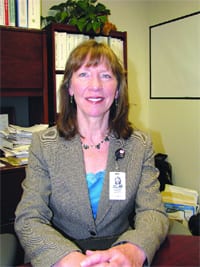A Tan Is Not a Sign of Health
Let’s put it out there — I’m a fair-skinned redhead who grew up believing a tan was a sign of health. I spent summers as a lifeguard and vacations at the beach, and I never wore sunscreen. I started each summer creating that golden-brown tan of my girlhood with a painful sunburn, like a base coat of paint. Hey, we all did. It was a sign that summer was here, right?
I use different base coats now — like sunscreen and sun-protective clothing. I avoid the sun at peak midday hours, and I spend a lot of time advocating for sun safety. Why? Because I had melanoma, the most deadly form of skin cancer. I learned the hard way: A tan is not a sign of health.
My battle with melanoma began in 2002, after I noticed a small, irregular mole on my lower back. I endured six months of medical tests trying to figure out why I was constantly sick and had low energy, and the mole was the last thing to test. I was anxious to see if this mole had anything to do with my constant sickness and fatigue. It did. Four days after my biopsy, my mother appeared at my door and sat me down to deliver the news: I had stage II melanoma.
To date, I’ve undergone 28 biopsies and had three melanomas surgically removed. I’ve been melanoma-free since 2003, but have had other non-melanoma skin cancers removed since then.
As an adult, my vacations centered around sunbathing. My Jamaican mother and family had the dark skin I wanted to emulate. And yet, they protected their skin and insisted I do the same. Their message went unheeded. In fact, I still had a visible tan line two months after my first melanoma surgery. I was embarrassed and viewed my tan as a badge of shame. I apologized to the melanoma surgical team during anesthesia. But I learned that knowledge is power. Skin cancer is the most preventable of all cancers. Vacations now center around better things than sunbathing. Discovering melanoma changed my life. I became an advocate for sun safety and found a new passion and a new job.
I had been a newspaper reporter, editor, and publicist. A clinical-trial nurse read my background and suggested calling the state health department to volunteer. I took her advice and a job offer to create a sun-safety program. I focused on K-8 schools because they embraced sun safety. I literally went door-to-door asking schools to give me 10 minutes of staff meeting time. That was 12 years ago.
Today, our program is a state education mandate. I meet with schools and organizations throughout Arizona, giving more than 300 presentations a year, with bags of plastic beads that turn colors when exposed to ultraviolet rays from the sun or the type of lamps found in tanning booths. The beads help kids from kindergarten to high school see right away that ultraviolet rays may be invisible and impossible to feel, but they exist and can damage your skin regardless of skin color. In fact, I tell students about the famous Jamaican reggae singer, Bob Marley, who died of melanoma.
Knowledge is power, and I want to equip children with tools to protect them against sun damage. I also want to help them form habits that will last a lifetime.
Skin damage is cumulative. It’s not like you start fresh every summer. Your sunburns and tans will fade, but your cells have ‘memory.’ We don’t know what amount of UV exposure sets the wheels in motion. It’s different for each person, but we do know ways to reduce your risk of skin cancer.
Since my diagnosis, when my now-teenage son was 5 years old, I’ve kept a colorful basket of sunscreens on the kitchen counter. Young or old, everyone knows the rule: sunscreen is a must at our house. I wash my son’s clothes in a laundry treatment with ultraviolet protectant. I’ve made using sunscreen a regular habit like brushing your teeth. Make sun safety ‘cool.’ Who wants leathery skin? And have you noticed how cool you look wearing shades?
I’ve been blessed to turn lemons into lemonade. I get paid to obsess about my affliction and to meet with the brightest minds in the field of skin-cancer prevention. I’ve dedicated the last 12 years to making a difference and have learned it all comes down to these simple messages: skin cancer is preventable. Don’t burn. Don’t tan. Protect your skin. Simply keep your skin the color it came in, and you, too, can make a world of difference. –

